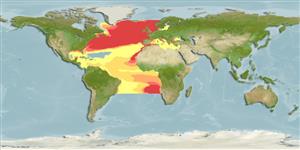Common names from other countries
Teleostei (teleosts) >
Beloniformes (Needle fishes) >
Scomberesocidae (Sauries)
Etymology: Scomberesox: Latin, scomber = mackerel + Esox, the old name for "pike" (Ref. 45335).
More on author: Walbaum.
Environment: milieu / climate zone / depth range / distribution range
Ecology
Marine; pelagic-oceanic; oceanodromous (Ref. 51243); depth range 0 - 30 m (Ref. 6531). Subtropical; 66°N - 22°S, 98°W - 36°E
Arctic (Ref. 43202). North Atlantic. Eastern Atlantic: Iceland, Norway and Denmark (rarely), along British Isles into Baltic Sea and throughout the Mediterranean, Adriatic and Aegean seas to Morocco. Western Atlantic: Gulf of St. Lawrence, Canada to North Carolina, USA and Bermuda (Ref. 7251). Highly migratory species.
Length at first maturity / Size / Weight / Age
Maturity: Lm 26.5, range 25 - ? cm
Max length : 50.0 cm TL male/unsexed; (Ref. 7251); common length : 32.0 cm TL male/unsexed; (Ref. 3397)
Oceanic, schooling and gregarious. Occasionally shoals close to shore in large numbers (Ref. 9987). Feeds on zooplankton and fish larvae (Ref. 9987); food also includes fish eggs and small fishes (Ref. 5951). Preyed upon by fish, including tunas, marlin bluefish and cod (Ref. 9987); also pollock, dolphins and porpoises (Ref. 5951). It is an under-exploited fish in many parts of its range and suitable for canning and other inexpensive uses (Ref. 9987). Often leap of the water when chased by enemies (Ref. 35388).
Distinct pairing (Ref. 205). Presence of asynchronous oocyte development in the ovaries (Ref. 109439).
Wisner, R.L., 1990. Scomberesocidae. p. 598-603. In J.C. Quero, J.C. Hureau, C. Karrer, A. Post and L. Saldanha (eds.) Check-list of the fishes of the eastern tropical Atlantic (CLOFETA). JNICT, Lisbon; SEI, Paris; and UNESCO, Paris. Vol. 2. (Ref. 6531)
IUCN Red List Status (Ref. 130435)
CITES (Ref. 128078)
Not Evaluated
Threat to humans
Harmless
Human uses
Fisheries: minor commercial; bait: occasionally
Tools
Special reports
Download XML
Internet sources
Estimates based on models
Preferred temperature (Ref.
115969): 6.5 - 22, mean 14.4 (based on 7800 cells).
Phylogenetic diversity index (Ref.
82804): PD
50 = 0.6562 [Uniqueness, from 0.5 = low to 2.0 = high].
Bayesian length-weight: a=0.00214 (0.00103 - 0.00444), b=3.10 (2.90 - 3.30), in cm Total Length, based on LWR estimates for this species & (Sub)family-body (Ref.
93245).
Trophic level (Ref.
69278): 3.9 ±0.0 se; based on diet studies.
Resilience (Ref.
120179): Medium, minimum population doubling time 1.4 - 4.4 years (Assusming tm=2-4).
Fishing Vulnerability (Ref.
59153): Low vulnerability (24 of 100).
Climate Vulnerability (Ref.
125649): Low to moderate vulnerability (29 of 100).
